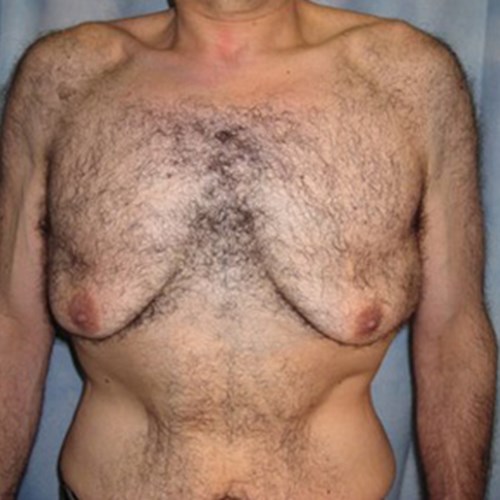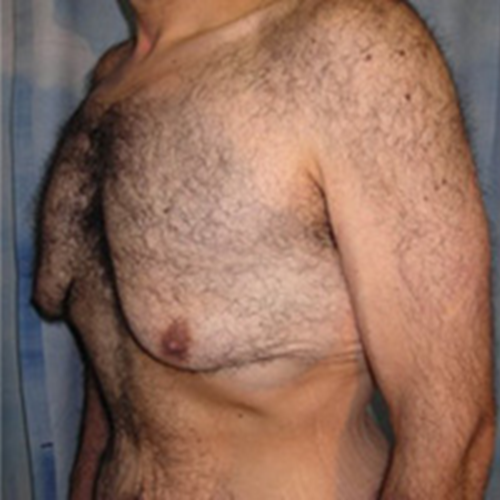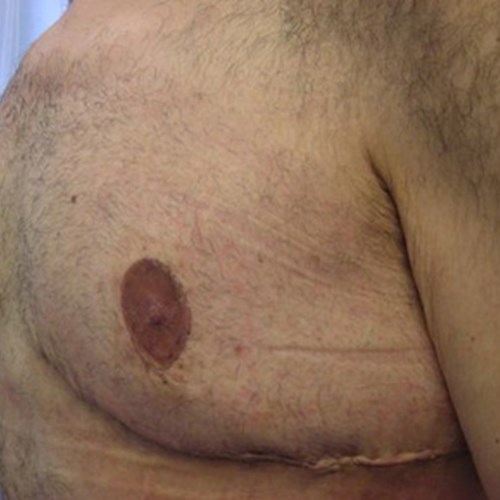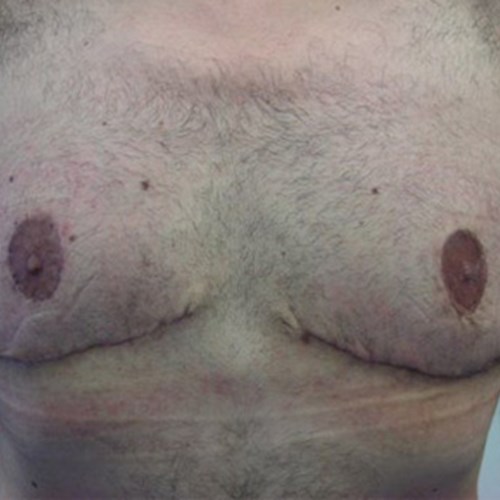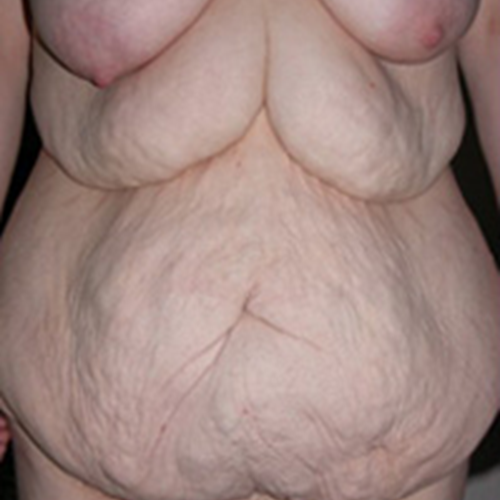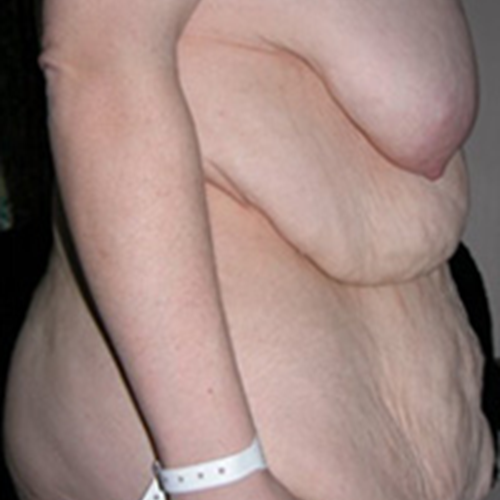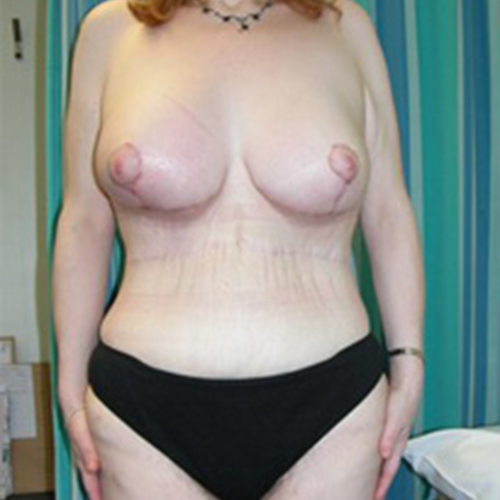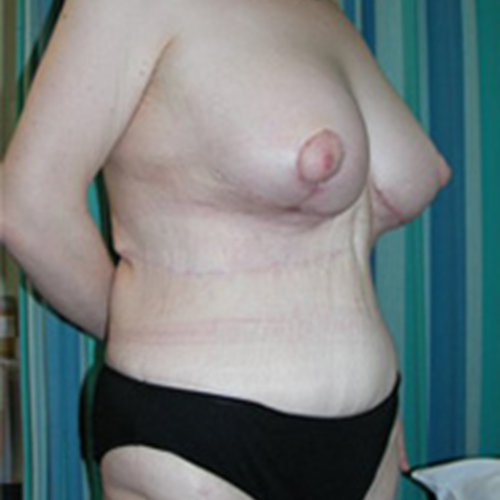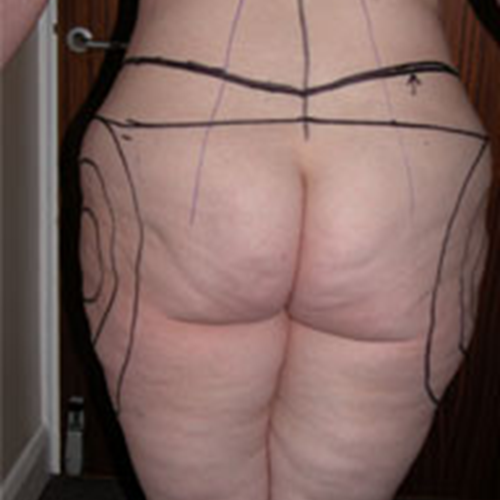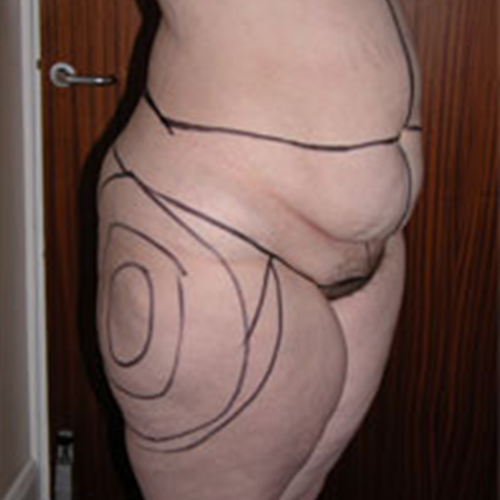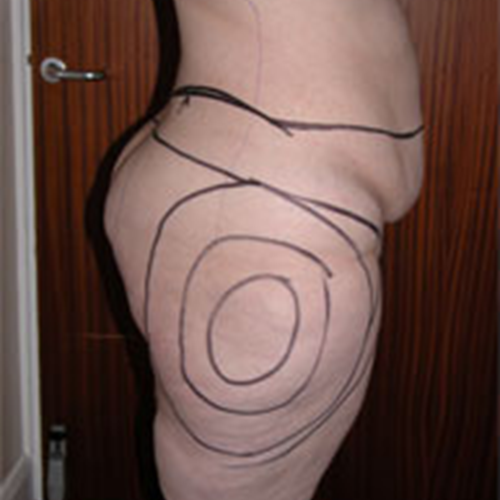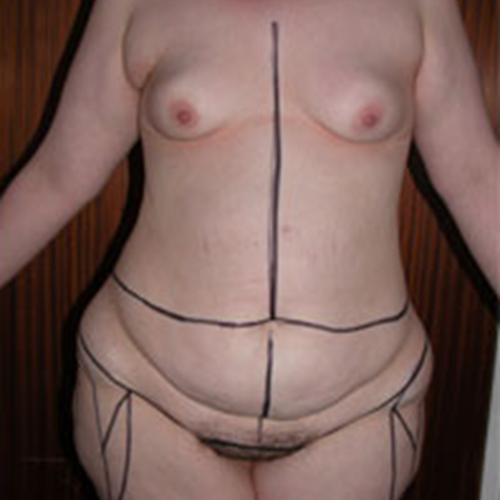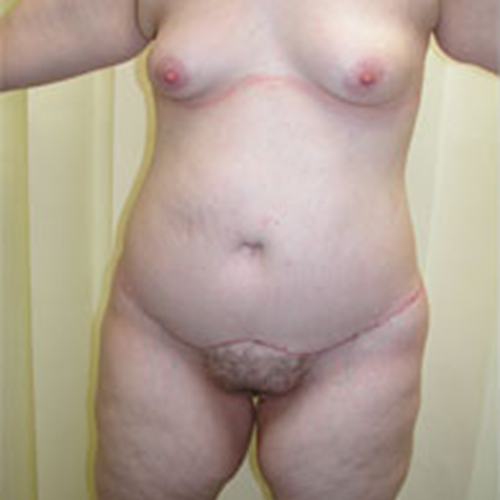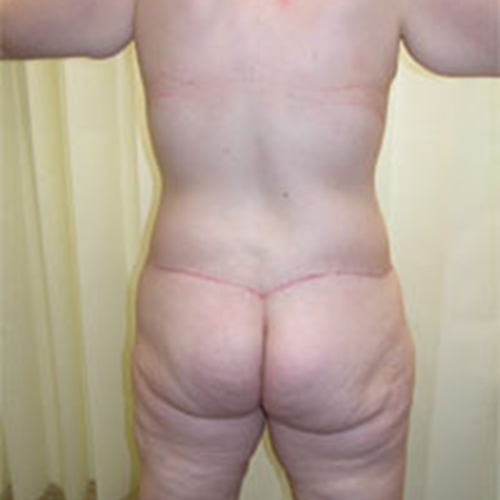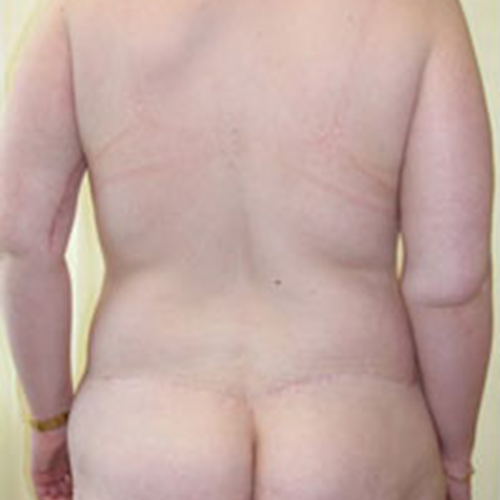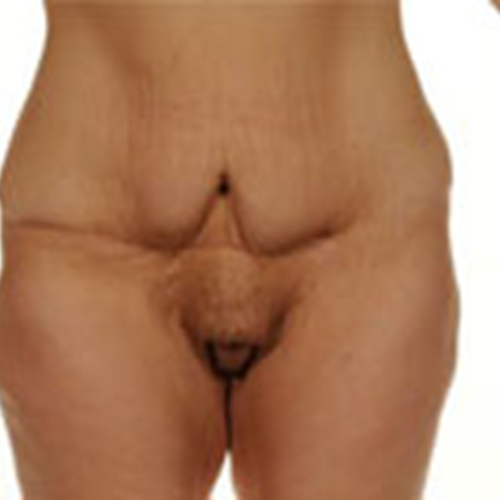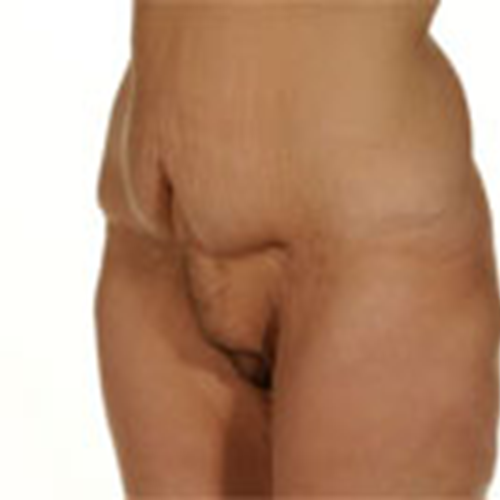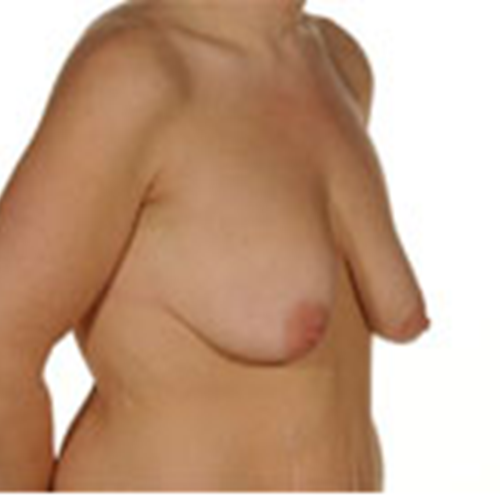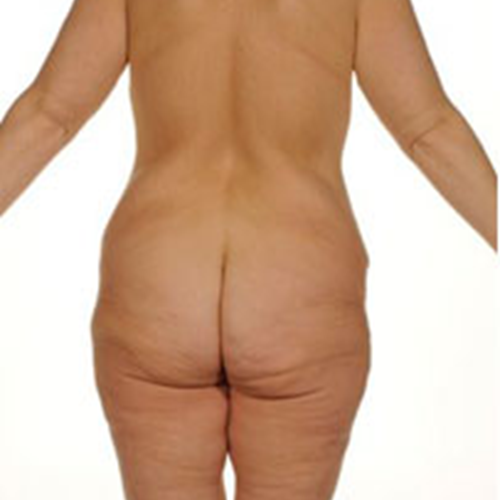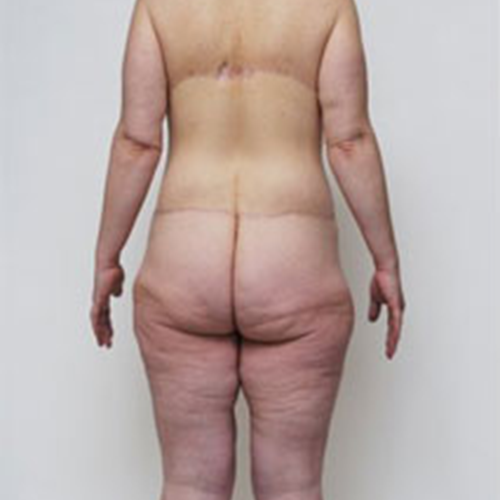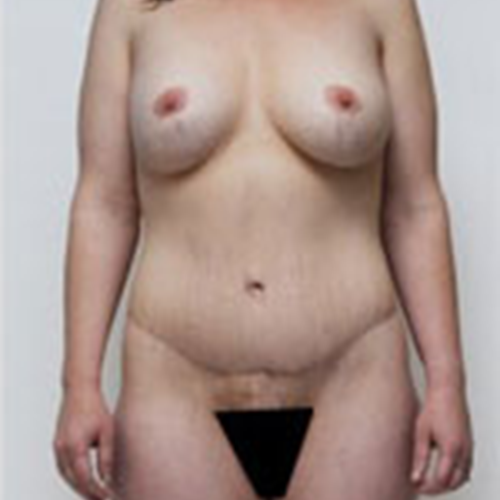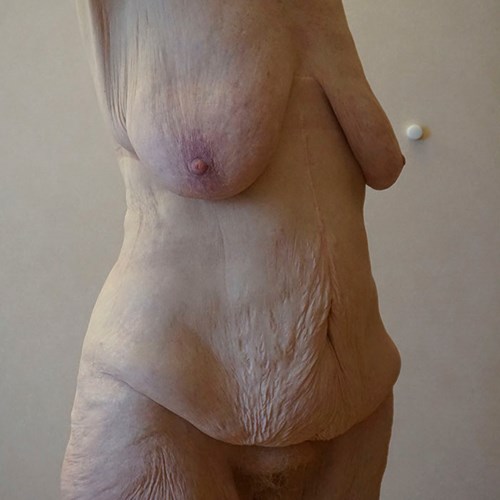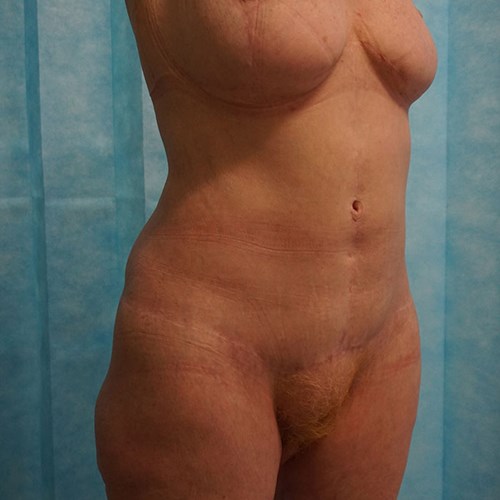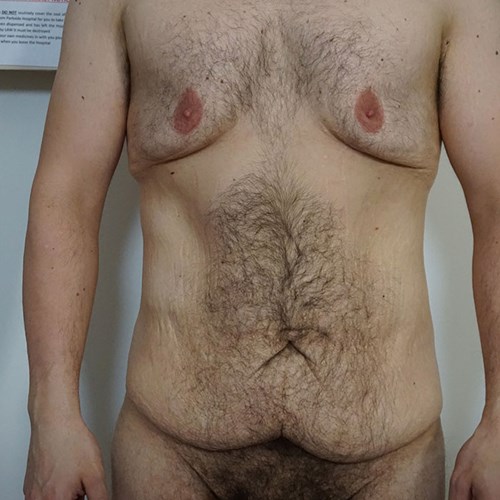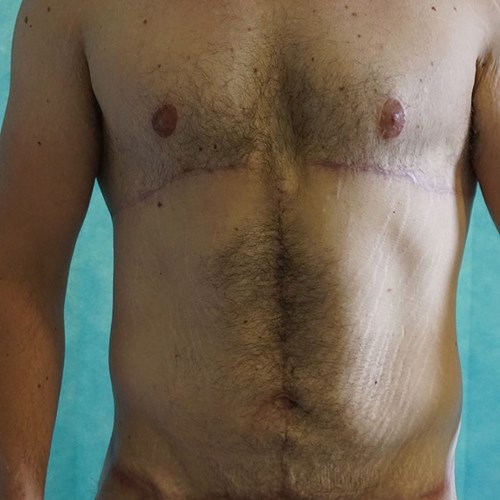Most patients wish to have the excess abdominal tissue removed first. These patients usually require a belt lipectomy which involves removal of tissue from around the lower trunk. This operation removes the overhanging belly, lifts the mons pubis, removes folds from the lower back and lifts the anterior/lateral thighs and buttocks. A belt lipectomy operation is performed under general anaesthesia and usually requires hospitalisation of 2-3 days. The operation starts with you in the prone position (facing down) and the excess tissue is removed from your lower back. While still asleep you are turned over so that I can perform the abdominoplasty component of the surgery on the front of your tummy. An incision is made from hip to hip connecting with the back incision, and around the belly button. A large wedge of skin and fat is excised from above the belly button to just above the pubic hair. Some areas may be treated with liposuction and the muscles above and below the belly button can be tightened. Although this operation does leave the biggest scar, it does provide the greatest degree of improvement in shape. Patients still planning pregnancies should wait until completion of their family before undergoing abdominal contouring surgery. The belt lipectomy or other suitable lower trunk procedure can be combined with other site surgery depending on your fitness. Subsequent operations involve lifting and filling empty breasts, arm and thigh tucks, and adjunctive liposuction. These can all be discussed with me when the time is right.
What can be expected at the initial consultation?
At the initial consultation you will be assessed as to whether you are a good candidate for surgery. Your entire body will be carefully examined to assess the skin quality, the quantity of fat and the muscle tone. Your general fitness for the procedure will be evaluated and the potential for problems sought. It is important to know about previous abdominal surgery, pregnancies, medication that you are on, previous leg or lung clots and whether or not you smoke. Your reasons for wanting the procedure will also be discussed. It is important that your expectations concerning the outcome of the procedure are realistic. If they are, you can expect to be happier with the result. When people lose a lot of weight it is in fact the entire skin envelope that changes and surgery cannot address everything. Addressing the areas that concern you the most is my priority. Once you have been fully assessed, an operative plan tailored to your individual needs will be formulated. The incision to be used, the amount of skin and fat to be excised, whether muscle tightening and navel repositioning is to be performed, and whether liposuction will be used as an adjunct will be discussed with you.
Do not be hesitant to ask questions, now or at any other time.
Medical aids or health insurance companies do not usually provide cover for this kind of surgery although occasionally a motivation can be done especially if you have lost large amounts of weight, or have a hernia.
Preparing for surgery
Ideally surgery is performed when you are fit and healthy. No special diet or exercise program is required. It is a good idea to have good fluid and protein intake for a few weeks before your operation. You should also clean the areas close to those undergoing surgery ( the perineum, buttocks, umbilicus before a belt lipectomy for example ).You should not have been on a long-haul flight for 2 weeks prior to surgery.
It is advisable to stop smoking at least six weeks prior to surgery and not to smoke until your wounds have healed - usually about two to three weeks after the operation. It is well known that there is a higher frequency of complications in patients who smoke.
On the morning of surgery you should wash well. Do not shave your pubic hair specifically. Prior to surgery, the incision lines will be marked with a pen in your room. Mr Soldin usually takes photographs for your records immediately before surgery.
The Surgery
Surgery will be performed in an operating theatre under general anaesthesia. You will need a urinary catheter to monitor fluid balance, and may need blood during or after the operation. A belt lipectomy takes between three to five hours depending on what will be done.
Following surgery the wounds are closed with dissolving sutures, and drains may well be left in place for a few days. Dressings and an elasticised garment will be applied.
What can be expected after the operation?
Following the operation you should be relatively pain free although you may feel some discomfort with movement. Post-operatively, you will be given strong painkillers if needed (such as opiates) and patient controlled analgesia (PCA) can be arranged for in-patients. With PCA you control the amount of painkiller that you receive - it is effective and safe.
You will be allowed to eat and drink once you are awake. As an in-patient, you will be well looked after in hospital and gentle mobilisation will be started as soon as you are awake. Immediately after surgery you should start with wiggling your toes and ankle and knee movements to help prevent leg clots. Avoid crossing your legs in bed. On the first post-operative day you should mobilise to a chair, walk to the bathroom and a little around your room. Daily showers are encouraged. Once the drains have dried up, they are removed and you can go home. Occasionally if the drains have not dried up, you will need to either stay another day or go home with the drain. This is easy to manage with some simple advice. Someone will need to drive you home and look after you. I advise that you have homecare for the first week to two, and that you have stocked up on all essentials before surgery. You will be given painkillers to take home with you. At home you should mobilize gently and rest frequently. On the first day back at home after surgery, you should try to get up into a comfortable chair and would be encouraged to walk around within the house. Following the first week of gentle mobilisation, you could get around a bit more – walks in the park and to the local shops are fine. After two weeks you can usually drive again.
How long does it take to get back to normal?
Healing is a variable process and it may take you a month or longer to feel like your old self again. People vary enormously in their recovery period. At home you need to take it easy but do not take to your bed. You will need help if you have small children for 2 weeks. Gradually increase your walking day by day. Do not drive until you really feel well – usually 2 weeks. Shower daily to stay clean. When discharged from hospital you will be provide with comfortable elasticated tubigrip. If your tubigrip becomes blood-stained, wash and dry it before reapplying it. After two weeks you will need to change to a more inconspicuous elasticated support garment. Mr Soldin uses MACOM, a web based garment supply company – please order the relevant elasticated support garments before your operation. The wounds are sealed by the end of the first week, but the scars continue to mature for up to 18 months, by which stage they should be thin, fine, inconspicuous lines. Massage of the scars with an aqueous cream helps, but should only be started after 1 month. Bruising take about 2 - 3 weeks to settle. Although the improvement is immediately seen after surgery, swelling can take up to 12 months to settle fully. To help diminish swelling and bruising abdominal support as described above should be worn for 6 weeks. Return to work is usually after one month to six weeks depending on your job. You will find that contrary to what you expect, your mood will be down following surgery and you may feel depressed, even tearful. You will also feel tired. This is a normal occurrence and as the swelling and bruising subside and your body heals, so your mood will elevate and improve. Mobilisation should be gentle, but begun early. Thereafter mobilisation should progress so that gentle exercises can be begun about one month after surgery. Return to work by a month and sport by 6 weeks is usual. Vigorous exercise should be avoided for six weeks, until you feel comfortable – your body will tell you if you are pushing it too hard.
What are the risks?
When performed by a qualified plastic surgeon, belt lipectomy is normally safe and the results predictable. Please be aware that all surgery has limitations – surgery on your lower trunk has less improvement on the upper trunk. A belt lipectomy is circumferential lower trunk surgery – the scar is above the buttocks on the lower back - the upper buttocks is much improved ( but the lower buttocks less so ). In the front the scar lies above the mons pubis – the mons pubis is elevated ( or reduced in size ), the upper anterior and lateral thighs are lifted and tightened ( but the inner thigh is not improved at all ). The lower abdomen is tightened – but this needs to be done safely as removing too much tissue and closing the wounds too tightly risks the wounds opening up again. These are some of the limitations of the belt lipectomy – an improvement is expected, but a magical new tummy is not possible. Secondary liposuction or even a reverse abdominoplasty may be needed if the tissue laxity / hang is severe after weight loss.
All surgery carries risks and for lower trunk surgery the following may happen:
Sensory alterations in the area - numbness below the belly button occurs in nearly all patients but is usually transient. Can take up to two years to resolve, and may not resolve completely. Bleeding (uncommon 1-5%) which can lead to a blood collection ( haematoma ) may require return to theatre for evacuation. Fluid collection ( seroma ) may require drainage with a syringe or, rarely, repeat open operation. Infection ( uncommon <2% ) at the operative site or elsewhere (e.g., pneumonia). Deep breathing and coughing is encouraged immediately after surgery to help prevent lung problems. Loss of tissue (necrosis), especially low down, near the scar or of the belly button can occur as the operation interferes with the blood supply of the tissues. If this occurs it is usually small and treated with dressings. Unsatisfactory scarring - usually not keloid, but scars can stretch or become raised and red. Asymmetries in contour or scar placement can occur and may need revision surgery to correct.
Clots in the legs which can migrate to the lungs are rare. The early mobilisation helps to minimise the risks of this. Problems with anaesthesia, drugs, fluid balance are also possible. These should be rare and the risks will be explained to you by your anaesthetist.
Will the new look last?
Belt lipectomy produces excellent results for patients following massive weight loss. In most cases the results are long lasting, especially if after the operation you avoid weight gain, follow a balanced diet and exercise regularly. Ageing, weight gain/loss, and pregnancies will affect your body and your lower trunk. Remember that realistic expectations are important.
Checklist before coming into hospital
Bring all your usual medication, toiletries and pyjamas.
No smoking (six weeks), and no aspirin (2 weeks) before the operation
If you are worried post-operatively
Telephone the ward of the hospital from which you have been discharged.
Telephone my secretary Angie Harrison during office hours – 07961221874
In an emergency (and you have failed to contact me by the above two methods) then please telephone St George’s Hospital (020 8672 1255) and ask them to either bleep me or the Resident Plastic Surgery doctor on call (Bleep 7050).
